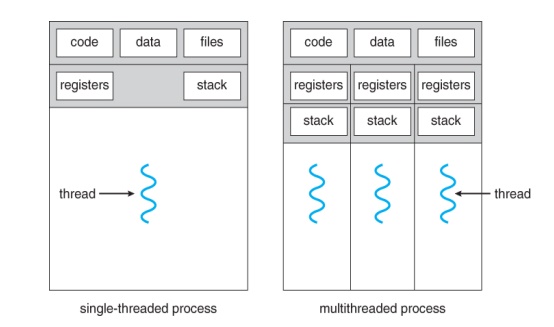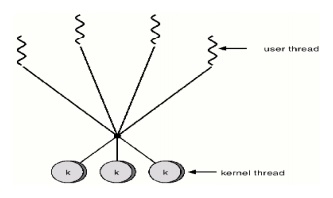Chapter: Operating Systems : Process Scheduling and Synchronization
Threads
THREADS
ü A thread
is the basic unit of CPU utilization.
ü It is
sometimes called as a lightweight process.
ü It
consists of a thread ID, a program counter, a register set and a stack.
ü It shares
with other threads belonging to the same process its code section, data
section, and resources such as open files and signals.
ü A
traditional or heavy weight process has a single thread of control.
ü If the
process has multiple threads of control, it can do more than one task at a
time.

1. Benefits of multithreaded
programming
v Responsiveness
v Resource
Sharing
v Economy
v Utilization
of MP Architectures
2. User
thread and Kernel threads
2.1. User threads
·
Supported above the kernel and implemented by a
thread library at the user level.
·
Thread creation , management and scheduling are
done in user space.
·
Fast to create and manage
·
When a user thread performs a blocking system call
,it will cause the entire process to block even if other threads are available
to run within the application.
·
Example: POSIX Pthreads,Mach C-threads and Solaris
2 UI-threads.
2.2.Kernel threads
·
Supported directly by the OS.
·
Thread creation , management and scheduling are
done in kernel space.
·
Slow to create and manage
·
When a kernel thread performs a blocking system
call ,the kernel schedules another thread in the application for execution.
·
Example: Windows NT, Windows 2000 , Solaris 2,BeOS
and Tru64 UNIX support kernel threads.
·
Multicore Programming
A recent
trend in computer architecture is to produce chips with multiple cores,
or CPUs on a single chip.
A
multi-threaded application running on a traditional single-core chip would have
to interleave the threads.
On a
multi-core chip, however, the threads could be spread across the available
cores, allowing true parallel processing.

Concurrent execution on a single-core system.

ü For
operating systems, multi-core chips require new scheduling algorithms to make
better use of the multiple cores available.
ü As
multi-threading becomes more pervasive and more important (thousands instead of
tens of threads), CPUs have been developed to support more simultaneous threads
per core in hardware.
3.1 Programming Challenges
ü For
application programmers, there are five areas where multi-core chips present
new challenges:
1. Identifying
tasks - Examining applications to find activities that can be performed
concurrently.
2. Balance - Finding
tasks to run concurrently that provide equal value. i.e. don't waste a
thread on trivial tasks.
3. Data
splitting - To prevent the threads from interfering with one another.
4. Data
dependency - If one task is dependent upon the results of
another, then the tasks need to be synchronized to assure access in the
proper order.
5. Testing
and debugging - Inherently more difficult in parallel processing
situations, as the race conditions become much more complex and difficult
to identify.
3.2
Types of Parallelism
In
theory there are two different ways to parallelize the workload:

1. Data parallelism divides the data up
amongst multiple cores ( threads ), and performs the same task on each subset of the data. For example
dividing a large image up into pieces and performing the same digital image
processing on each piece on different cores.
2. Task parallelism
divides the different tasks to be
performed among the different cores and performs them simultaneously.
In
practice no program is ever divided up solely by one or the other of these, but
instead by some sort of hybrid combination.
2.5.4 Multithreading
models
1. Many-to-One
2. One-to-One
3. Many-to-Many
1. Many-to-One:
Many
user-level threads mapped to single kernel thread.
Used on
systems that do not support kernel threads.

2.One-to-One:
Each user-level thread maps to a kernel thread.
ü Examples
- Windows
95/98/NT/2000
- OS/2
3. Many-to-Many
Model:
ü Allows
many user level threads to be mapped to many kernel threads.
ü Allows
the operating system to create a sufficient number of kernel threads.
v Solaris 2
v Windows NT/2000
Related Topics